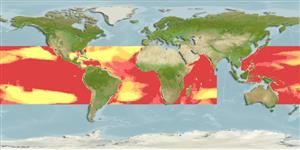>
Myctophiformes (Lanternfishes) >
Neoscopelidae (Blackchins)
Etymology: Scopelengys: Greek, skopelos = a lantern fish + Greek, eggys = near (Ref. 45335); tristis: tristis meaning dull, alluding to its dull blackish color (Ref. 4525).
More on author: Alcock.
Environment: milieu / climate zone / depth range / distribution range
Ecologia
marino batipelagico; oceanodromo (Ref. 51243); distribuzione batimetrica 400 - 1830 m (Ref. 58018). Deep-water; 35°N - 35°S
Western Indian Ocean: 6°N to 34°S. Probably Somalia (Ref. 30573). Western Pacific. Eastern Pacific: southern California, USA to Chile. Western Atlantic: off Venezuela (Ref. 6690) and Guianas (Ref. 13608). Eastern Atlantic: Morocco to Angola; one record from South Africa (Ref. 6604). South China Sea and East China Sea (Ref.74511).
Size / Peso / Age
Maturity: Lm ? range ? - ? cm
Max length : 20.0 cm SL maschio/sesso non determinato; (Ref. 4481)
Spine dorsali (totale) : 0; Raggi dorsali molli (totale) : 11 - 13; Spine anali: 0; Raggi anali molli: 12 - 14. Uniform brown in color, mouth and belly darker (Ref. 6604). Branchiostegal rays: 8 (Ref. 36062). Lacks luminous organs and a gas bladder (Ref. 36062).
High-oceanic and bathypelagic (Ref. 6604). Adults usually found below about 1,000 m, but juveniles found between 500-800 m. No evidence of vertical migration (Ref. 6604). Feed mainly on small crustaceans. Sexually mature from about 15.2 cm (Ref. 4525). Oviparous, with planktonic larvae (Ref. 36062).
Life cycle and mating behavior
Maturità | Riproduzione | Deposizione | Uova | Fecundity | Larve
Eschmeyer, W.N., E.S. Herald and H. Hammann, 1983. A field guide to Pacific coast fishes of North America. Boston (MA, USA): Houghton Mifflin Company. xii+336 p. (Ref. 2850)
IUCN Red List Status (Ref. 130435: Version 2024-1)
Threat to humans
Harmless
Human uses
Pesca: di nessun interesse
Strumenti
Special reports
Download XML
Fonti Internet
Estimates based on models
Preferred temperature (Ref.
123201): 4.2 - 7.7, mean 5.7 °C (based on 645 cells).
Phylogenetic diversity index (Ref.
82804): PD
50 = 0.7656 [Uniqueness, from 0.5 = low to 2.0 = high].
Bayesian length-weight: a=0.00933 (0.00367 - 0.02375), b=3.08 (2.86 - 3.30), in cm total length, based on LWR estimates for this (Sub)family-body shape (Ref.
93245).
Trophic level (Ref.
69278): 3.1 ±0.30 se; based on food items.
Generation time: 2.4 ( na - na) years. Estimated as median ln(3)/K based on 1
growth studies.
Resilienza (Ref.
120179): Medio, tempo minimo di raddoppiamento della popolazione 1.4 - 4.4 anni (Assuming tmax>3).
Fishing Vulnerability (Ref.
59153): Low to moderate vulnerability (27 of 100).
